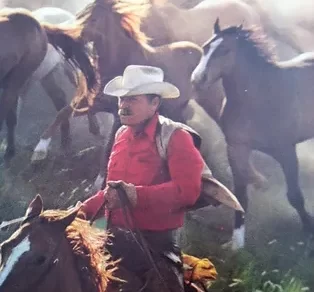Darrell Winfield was a cowboy and rancher all his working life, for twenty-one years in California’s San Joaquin Valley and forty-six years in Wyoming.
“As long as I can remember,” Darrell said, “I always wanted to be a cowboy. I remember seeing guys horseback when I was going to grammar school. They’d be driving cattle by the school, and I’d think, God, that would be nice to be able to do that.”
Born in Kansas, Oklahoma, in 1929, Darrell moved with his family to California when he was six, where his dad worked on ranches and owned a dairy farm.
Darrell’s earliest memories were of trying to spend as much time as possible on a horse or work mule. After his sophomore year in high school, he ran away with a carnival and traveled up and down the state, in charge of the horses and pony rides. He returned to the San Joaquin Valley when he was seventeen, married Lennie Spring when he was eighteen, and launched into his life as a full-time working cowboy.
When he was twenty, he went to work for cattleman William Holt Nobel, first as a cowboy and then as cowboss for twelve years. Both at work and after work, and in rodeos, Darrell team-roped as much as he could. After two years in the cattle business with a partner, the bottom fell out of beef prices and Darrell returned to work as a cowboy and foreman on the Eastside Ranch in the San Joaquin Valley.
In 1968, Darrell moved with his family to Daniels, Wyoming, where he became cowboss at the Quarter Circle 5 Ranch, running up to six thousand head of cattle in the mountains. There he was discovered by the Leo Burnett Advertising Agency during a Marlboro Country shoot on the ranch. For the next twenty years, Marlboro ads and commercials focused on Darrell as the main Marlboro Man, and he continued to appear in advertising for a total of thirty years.
“You could look at the different cowboys that we’ve used and you could argue that they were all the Marlboro man,” a company spokesman told the New York Times in 1992. “But Darrell is really the Marlboro man.” During his time as the Marlboro Man, Darrell never left ranch work. In an interview for the Museum of American History, he said he thought his life would have been basically the same if he hadn’t been given the chance to work for Marlboro.
In 1974, Darrell moved to Riverton, Wyoming, where for the next four decades on his eighty-acre ranch he raised, trained, bought, sold, and swapped quarter horses. WD was his brand. Horses were what he loved to be around, whether in the saddle for Marlboro or at rodeos for team-roping competitions as a member of the Rodeo Cowboy Association (RCA), later the PRCA.
Until his death at eighty-five at his Riverton ranch, Darrell Winfield remained devoted to the cowboy way of life. He also became the strongest image of the iconic American cowboy in popular culture. In life and legend, he was the same cowboy.


